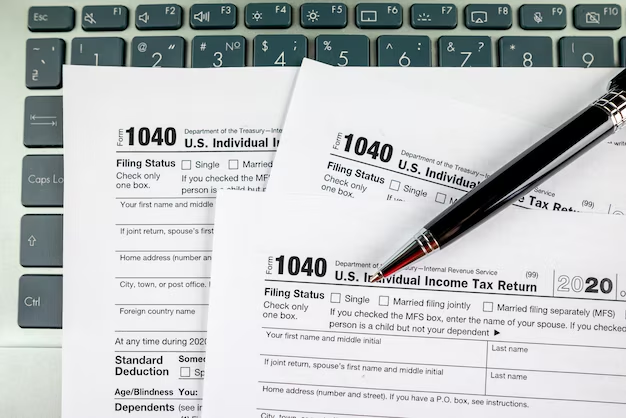Demystifying the IRS 1040 Form: What You Need to Know
Navigating the world of taxes can be as thrilling as watching paint dry, yet it's an inescapable reality for millions. In the realm of U.S. taxation, understanding the IRS 1040 Form stands as a fundamental necessity. Whether you're a seasoned taxpayer or filing for the first time, this guide aims to shed light on the essentials of the 1040 Form, making your tax season as painless as possible.
🎯 Understanding the Basics: What is an IRS 1040 Form?
The IRS 1040 Form is the backbone of personal income taxes in the United States. Officially titled the "U.S. Individual Income Tax Return," this document is used by individuals to file their annual tax returns. It determines how much individuals owe the federal government or how much a refund they will receive.
Key Features of the 1040 Form
- Purpose: The main purpose is to report your income, claim deductions, and calculate the amount of tax owed or refund due.
- Versatility: Suitable for a wide range of filer situations, whether simple or complex.
- Annual Requirement: Must be filed annually by April 15, with some exceptions.
The IRS 1040 Form has seen various iterations over the years, evolving to meet the changing needs of taxpayers. Today, it’s designed to cater to diverse situations, with a number of attached schedules to address specific cases.
🕵️♂️ Who Needs to File a 1040?
While the majority of Americans must file, certain thresholds and situations dictate who is obligated to submit a 1040 Form. Here's a quick check to see if you might need to file:
- Income Levels: Generally, if your gross income exceeds certain limits, you must file. These limits vary based on age and filing status (single, married, etc.).
- Dependency: If you are a dependent with unearned income exceeding a certain amount.
- Self-Employment: Those with self-employment earnings above a minimal level.
Other factors, such as the amount of health savings account distributions, might also necessitate filing.
🔍 Exploring the Different Parts of the 1040 Form
Understanding the 1040 involves dissecting its key components and sections. Here's a breakdown of what you'll encounter:
Personal Information
This section gathers basic details, such as your name, Social Security number, and filing status.
Income Information
You'll report various sources of income, from wages and salaries to dividends and self-employment income.
Deductions and Credits
This is where taxpayers can subtract certain expenses or credits to reduce taxable income. Common deductions include student loan interest and retirement account contributions.
Tax and Payments
This part calculates the actual tax liability, taking into account any prepayments or withholdings already made.
🧾 Different Versions of the 1040 Form
While the standard 1040 Form covers most needs, alternative versions exist to address specific situations.
The 1040-SR for Seniors
Designed with larger print and simplified language, this form assists taxpayers aged 65 and older.
The 1040-NR for Nonresident Aliens
For those with income from a U.S. source but not living in the U.S. full-time.
The 1040-X for Amendments
Used when taxpayers need to correct or modify a previously filed return.
📊 Summary of Key Points
Let's recap the essentials with a quick, visually engaging summary:
| Key Aspect | Description |
|---|---|
| 🔑 Purpose | File annually to report income, claim deductions, and calculate tax or refund. |
| 👥 Who Files | Income over thresholds, dependents, self-employed, etc. |
| 📄 Main Sections | Personal info, income, deductions, credits, tax calc. |
| 📌 Special Forms | 1040-SR, 1040-NR, and 1040-X for specific needs. |
🌟 Tips for Filling Out Your 1040 Form
Filing taxes doesn't need to be a stress marathon. Consider these handy tips to make the filing process smoother:
- Organize Documents Early: Keep track of W-2s, 1099 forms, mortgage statements, etc.
- Use Tax Software: Consider using reputable tax software to streamline calculations and filing.
- Double-Check Entries: Avoid common errors by verifying Social Security numbers, and all financial entries.
- Consider Professional Help: If your financial situation is complex, engaging a tax professional might save time and stress.
🤔 Frequently Asked Questions
Is There a Penalty for Filing Late?
Yes, failing to file by the deadline can result in penalties, though extensions might be available.
How Can I Get a Copy of My Filed Tax Return?
You can request a transcript through the IRS website or mail a Form 4506 for a full copy.
Can I File Electronically?
Absolutely! Electronic filing, or e-filing, is secure and expedites the return process.
📝 Closing Note on Navigating Tax Season
Understanding the IRS 1040 Form is essential to ensure you’re compliant with tax regulations and maximizing potential refunds. Arm yourself with knowledge, stay organized, and use tools and resources available to make tax time a breeze. Being informed prepares you to meet deadlines and potentially save money, transforming tax season into just another task rather than a daunting challenge.
Remember, taxes are a necessary part of civic life, and mastering them can enhance your financial management skills. Whether through DIY methods or expert consultations, ensuring your 1040 Form is accurately filed will give you peace of mind and possibly a welcome refund boost.

Related Topics
- Are Irs Economic
- Are Irs Economic Impact Payments Still Available
- Are We Getting Ctc Payments In 2024 Irs
- Can Form 8822 Be Faxed To Irs
- Can I Brown Act Irs
- Can I Call The Irs
- Can I Edit Any Irs Payment After I Did It
- Can I Go To Irs For Support
- Can I Have The Irs Apply My Overpayment If Divorced
- Can I Make Payments To The Irs